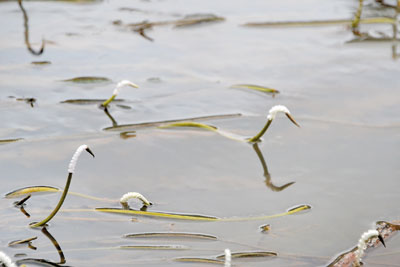Swaying in the water: A new species

Habitat of the new species: A. dassanayakei
She would tuck up her pants and wade barefoot into the mud of numerous tanks (wewas) dotting the Polonnaruwa district in search of the abundant Kekatiya (Aponogeton) trying to decipher whether the usual description both in Sri Lanka and the world of a particular species fit the image.
Kekatiya, a group of freshwater plants, had piqued her curiosity when she spotted these plants in the Kaudulla National Park in 2010. As these plants just didnât fit the descriptions given in the literature for Sri Lanka Aponogetons, Prof. Deepthi Yakandawala of the Department of Botany, Faculty of Science, University of Peradeniya took a specimen back to Peradeniya and set about âcoveringâ the whole island to get the full picture of Kekatiya.
It was far away from Kaudulla in the Dry Zone that she stumbled on the unexpected in the Kalutara district in the Wet Zone.
Aponogeton dassanayakei, a new species endemic to Sri Lanka (occurring only in this country), swaying this way and that on tiny ripples whipped up by a gentle wind on the Meegama ganga, a tributary of the Bentota river.
Launching an undergraduate research project with her student Chapa Manawaduge, later they had extended the study with funding from a university research grant of the Peradeniya University. On the field, in the collection of specimens they were helped by Priyadharshana of their department.
Referring to what makes Aponogeton dassanayakei different, Prof. Yakandawala explains simply that âmal pipena netten, malak neme enne, aluth pelayakâ. (What appears from the stem which is supposed to have flowers is not flowers but a new plant).
It is thereafter that she delves deep into the botanical details of the new species that they discovered during a three-year study and which was spotlighted in âPhytotaxaâ, a reputed international journal.
The âattention-grabbingâ character of this new Aponogeton species is its ability of vegetative propagation, where some members propagate through the formation of young plantlets/propagules at the tip of a long axis known as proliferous peduncles. âThis is a rare character that has never been recorded previously for any Sri Lankan Aponogeton,â says Prof. Yakandawala, pointing out that it has been reported only in two other species in the world.
They are A. proliferous, an Australian species with yellow-flowered inflorescences and A. undulates, an Asian species with white-flowered inflorescences. âHowever, this new species found in Sri Lanka is very different to A. undulates,â she reiterates.

Prof. Deepthi Yakandawala
This brings the number of the Aponogeton species described so far in Sri Lanka to six including four endemics.
The other three endemics are Aponogeton rigidifolius found in the Wet Zone areas of Kottawa and Kaneliya; Aponogeton jacobsenii restricted to Horton Plains; and the recent addition before the latest, Aponogeton kannangarae found at Morningside in the Sinharaja Rainforest.
The other two species, meanwhile, are Aponogeton crispus and Aponogeton natans which are native to the island and occur in the Dry Zone. âNativesâ mean that these plants have been living on the island landmass since its origin and, therefore, they occur in neighbouring countries as well.
The A. dassanayakei study considered samples from all over the country and evaluated more than 60 morphological characters as well as molecular characters (DNA). âBoth morphological and molecular evidence verify the identity of this plant as a new Aponogeton species,â says Prof. Yakandawala.
âDespite its small size, Sri Lanka has great biodiversity. There are over 370 aquatic or wetland plant species of which 12% are endemic. There are a few remarkable endemic aquatic plant species that are of ornamental value and they include Atiudayan (Cryptocoryne),Ketala(Lagenandra) and Kekatiya (Aponogeton),â she says.
She waxes eloquent on Kekatiya â the inflorescences and tubers of all species are edible and seem to be a popular source of food among local people. Traditionally, these have also been used in ayurvedic medicine as a diuretic, diluent and cholagogue and also in the treatment of acute and chronic cystitis, rheumatism, gonorrhoea and strangury. These plants are also known to have anti-inflammatory, anti-fungal and anti-diabetic activities. They are important aquatic ornamental plants and have brought in considerable foreign exchange.
The endemic Aponogeton species, meanwhile, provide favourable habitats for endemic aquatic fauna, says Prof. Yakandawala, warning that contemporary observations reveal a high possibility of some Aponogeton species becoming extinct from the wild.
Lamenting that one of the biggest drawbacks in conserving the biodiversity of the country is the lack of knowledge about what we actually have, she stresses that Aponogeton species may become extinct in the wild due to habitat destruction and over-exploitation.
Relevant sustainable measures to conserve these plants are essential, urges Prof. Yakandawala.

Chapa Manawaduge
New find named after eminent plant taxonomist   Prof. M.D. Dassanayake The new species which is found in Kalutara, Gampaha and Colombo districts has been named Aponogeton dassanayakei Manawaduge &Yakandawala, after the eminent plant taxonomist Prof. M.D. Dassanayake. It is as tribute to Prof. Dassanayake who was the General Editor of âA Revised Handbook to the Flora of Ceylonâ (Vols. IâXV) that the research paper on Aponogeton dassanayakei was published in September last year to coincide with his 95th birthday which was on the 17th. Having had to forego the opportunity of entering Medical School at the tender age of 17, due to the inability of his family to meet the costs, young Dassanayake instead read for a science degree at the Ceylon University College and later University of Ceylon. He was in the first batch of three students reading for the Botany Special Degree. Later funded by the University of Ceylon, he read for his MA at the University of Cambridge and PhD from the University of Manchester in the United Kingdom. After serving for more than four decades in the university system of Sri Lanka, he was awarded the status of Emeritus Professor by the University of Peradeniya in 1989. |
| Rectifying a feature lost in translationThe initial curiosity of Prof. Deepthi Yakandawala has also been laid to rest. Even though Aponogeton natans  has been described in Sri Lanka and elsewhere in the world as a plant with both floating and submerged leaves, it only has leaves floating on the water, Prof. Yakandawala and student Chapa Manawaduge have ascertained. âIt is likely that the misconception of submerged leaves in A. natans was propagated by a misinterpretation of the Latin description provided by Krause & Engler (1906) when translating into English,â says Prof. Yakandawala. This finding has also been published as a separate research article in âPhytotaxaâ. |


